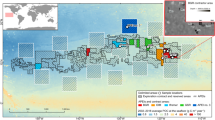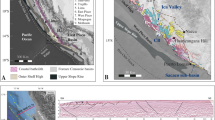Abstract
The Kopet-Dagh sedimentary basin is located in northeast of Iran and southeast of Turkmenistan in the Middle East. The Khangiran formation represents the last marine deposition in the Kopet-Dagh sedimentary basin. The early Eocene planktonic and benthic foraminifera from the Khangiran formation which belongs to the lower 376 m thickness of this formation are identified and biostratigraphically evaluated. Due to rarity of Morozovella species, planktonic foraminiferal zonation was difficult to determine in this formation. The determination of upper part of the late Paleocene for the lower 124 m of this formation is according to the lowest occurrence of Acarinina sibaiyaensis species. From E5 to near middle of E7 biozone, increasing trend of Acarinina frequency and a peak in Morozovella species and decreasing trend of frequency of Subbotina and Pseudohastigerina species indicate the warm and oligotrophic condition of the seawater during sedimentation of the studied interval. Toward the Ypresian-Lutetian boundary, the increasing trend of Pseudohastigerina and Subbotina species and decreasing in frequency of Acarinina species suggest the low-oxygen level, eutrophic and intermediate condition of the seawater. In this formation, the high abundance of the epifaunal taxa such as Anomalinoides spp., Cibicidoides spp., Gyroidinoides spp., and Lenticulina spp. from the base (late Paleocene sediments) up to E6 biozone reflects oligotrophic and oxic shallow water conditions. The occurrence of several peaks in abundance of Bulimina and Uvigerina species at the Ypresian/Lutetian boundary suggests eutrophic condition. These paleoecological conditions could be correlated with fluctuations in the numbers of the planktonic foraminifera.










Similar content being viewed by others
References
Afshar-Harb A (1979) The stratigraphy, tectonics and petroleum geology of the Kopet-Dagh region, northern Iran. Unpublished PhD thesis, Imperial College of Science and Technology, London, 316 p
Akrami MA (2004) Geological map of Iran. 1:100000 Series. Sheet No. 7864–7865, Dargaz. Geological Survey and Mineral Exploration of Iran
Alegret L, Ortiz S (2007) Global extinction event in benthic foraminifera across the Paleocene/Eocene boundary at the Dababiya stratotype section. Micropaleontol 52(5):433–447
Alegret L, Thomas E (2009) Food supply to the sea floor in the Pacific Ocean after the Cretaceous/Paleogene boundary event. Mar Micropaleontol 73:105–116
Anan HS (2015) Planktic foraminifera around the early/middle Eocene boundary in the United Arab Emirates and other Tethyan localities. Revue de Paléobiologie, Genève 34(1):11–25
Berggren WA, Aubert J (1975) Paleocene benthic foraminiferal biostratigraphy, paleobiogeography and palaeoecology of Atlantic-Tethyan regions: midway-type Fauna. Palaeogeogr Palaeoclimatol Palaeoecol 18:73–192
Berggren WA, Pearson PN (2005) A revised tropical to subtropical Paleogene planktonic foraminiferal zonation. J Foraminiferal Res 35:279–298
Bolli HM, Krasheninnikov VA (1977) Problems in Paleogene and Neogene correlations based on planktonic foraminifera. Micropaleontol 23(4):436–452
Bolli H, Beckmann J, Saunders JB (1994) Benthic foraminiferal biostratigraphy of the South Caribbean region. Cambridge University. 408p
Boukhary M, Bassiouni ME, Hewaidy A, Luterbacher HP, Al-Hitmi H (2011) Foraminifera and ostracodes of early Eocene Umm er Radhuma formation, Dukhan oil field, Qatar. Micropaleontol 57(1):37–60
Boukhary M, El Safori YA, Decrouez D, Faris MM (2006) Bio-and isotope stratigraphy of the lower/middle Eocene section at Gebel Hafit area, United Arab Emirates. N Jh Geol Palaont Mh 3:129–147
Corliss BH, Chen C (1988) Morphotype patterns of Norwegian Sea deep-sea benthic foraminifera and ecological implications. Geol 16:716–719
Creech JB, Baker JA, Hollis CJ, Morgans HEG, Smith EGC (2010) Eocene Sea temperatures for the mid-latitude Southwest Pacific from Mg/Ca ratios in planktonic and benthic foraminifera. Earth Planet Sci Lett 299:483–495
Field DB, Baumgartner TR, Charles CD, Ferreira-Bartrina V, Ohman MD (2006) Planktonic foraminifera of the California current reflect 20th-century warming. Sci 311:63–66
Gonzalvo C, Molina E (1998) Planktonic foraminiferal biostratigraphy across the lower-middle Eocene transition in the Betic cordillera (Spain). Neues Jahrbuch für Geologie und Paläontologie Mh 11:671–693
Haggag MA (1992) Planktonic foraminiferal groups and zonation of the Paleocene/Eocene of the south Galala and environs, Egypt. J Geol 35(1, 2):37–50
Jannink NT, Zachariasse WJ, Van der Zwaan GJ (1998) Living (rose Bengal stained) benthic foraminifera from the Pakistan continental margin (northern Arabian Sea). Deep-Sea Res I 45:1483–1513
Kitazato H, Ohga T (1995) Seasonal changes in deep-sea benthic foraminiferal populations: results of long-term observations at Sagami Bay, Japan. In: Sakai H, Nozaki Y (eds) Biogeochemical processes and ocean flux in the western Pacific. Terra Scientific Pubishing, Tokyo, pp. 331–342
Loeblich AR, Tappan HN (1988) Foraminiferal genera and their classification. Van Nostrand-Reinhold, New York 970p
Luciani V, Giusberti L, Agnini C, Backman J, Fornaciari E, Rio D (2007) The Paleocene-Eocene thermal maximum as recorded by Tethyan planktonic foraminifera in the Forada section (northern Italy). Mar Micropaleontol 64:189–214
Luciani V, Giusberti L, Agnini C, Fornaciari E, Rio D, Spofforth DJA, Pälike H (2010) Ecological and evolutionary response of Tethyan planktonic foraminifera to the middle Eocene climatic optimum (MECO) from the Alano section (NE Italy). Palaeogeogr Palaeoclimatol Palaeoecol 292:82–95
Nicolò MJ, Dickens GR, Hollis CJ, Zachos JC (2007) Multiple early Eocene hyperthermals: their sedimentary expression on the New Zealand continental margin and in the deep sea. Geol 35:699–702
Ortiz N (1995) Differential patterns of benthic foraminiferal extinctions near the Paleocene/Eocene boundary in the North Atlantic and the western Tethys. Mar Micropaleontol 26:341–359
Ortiz S, Thomas E (2006) Lower- middle Eocene benthic foraminifera from the Fortuna section (Betic cordillera, southeastern Spain). Micropaleontol 52(2):97–150
Pearson PN, Olsson RK, Huber BT, Hemleben C, Berggren WA (2006) Atlas of Eocene planktonic foraminifera. Cushman Foundation Special Pub 41:1–513
Sen Gupta BK (2000) Modern foraminifera. Kluwer Academic Publication. 371p
Stap L, Sluijs A, Thomas E, Lourens L (2009) Patterns and magnitude of deep sea carbonate dissolution during Eocene thermal maximum 2 and H2, Walvis ridge, southeastern Atlantic Ocean. Paleoceanogr 24:PA1211. doi:10.1029/2008PA001655
Thomas E (2007) Cenozoic mass extinctions in the deep sea; what disturbs the largest habitat on Earth? In: Monechi S, Coccioni R, Rampino M (eds.), Large ecosystem perturbations: Causes and consequences. Geol Soc Am Special Paper 1–24
Tjalsma RC, Lohmann GP (1983) Paleocene-Eocene bathyal and abyssal benthic foraminifera from the Atlantic Ocean. Micropaleontol Special Pub 4:1–90
Van Hinsbergen D, Kouwenhoven TJ, Van der Zwaan GJ (2005) Paleobathymetry in the back stripping procedure: correction for oxygenation effects on depth estimates. Palaeogeogr Palaeoclimatol Palaeoecol 221:245–265
Van Hinte JE (1978) Geohistory analysis-application of micropaleontology in exploration geology. AAPG Bull 62:201–222
Villanueva Guimerans P, Cervera Currado JL (1999) The recent Uvigerinids (benthic foraminifera) in the northeastern gulf of Cadiz. Boletino Del Instituto Espanol De Oceanografia 15(1–4):191–201
Wade BS (2004) Planktonic foraminiferal biostratigraphy and mechanisms in the extinction of Morozovella in the late middle Eocene. Mar Micropaleontol 51(1-2):23–38
Zachos JC, Dickens GR, Zeebe RE (2008) An early Cenozoic perspective on greenhouse warming and carbon-cycle dynamics. Nat 451:279–283
Acknowledgments
We are grateful to Mr. Savabi, Niazi, and Jahangiri for helping us in the sampling and to Ms. Hashemian for taking the scanning electron microscopy pictures in the Central Laboratory of Ferdowsi University of Mashhad in Iran. We are indebted to Prof. Anan (Al Azhar University-Gaza, Palestine) for his valuable suggestions that improved this manuscript. We also thank Dr. Luciani (Ferrara University, Italy) for the help with the identification of some of planktonic foraminiferal species.
Author information
Authors and Affiliations
Corresponding author
Rights and permissions
About this article
Cite this article
VahdatiRad, M., Vahidinia, M. & Sadeghi, A. Early Eocene planktonic and benthic foraminifera from the Khangiran formation (northeast of Iran). Arab J Geosci 9, 677 (2016). https://doi.org/10.1007/s12517-016-2711-4
Received:
Accepted:
Published:
DOI: https://doi.org/10.1007/s12517-016-2711-4




